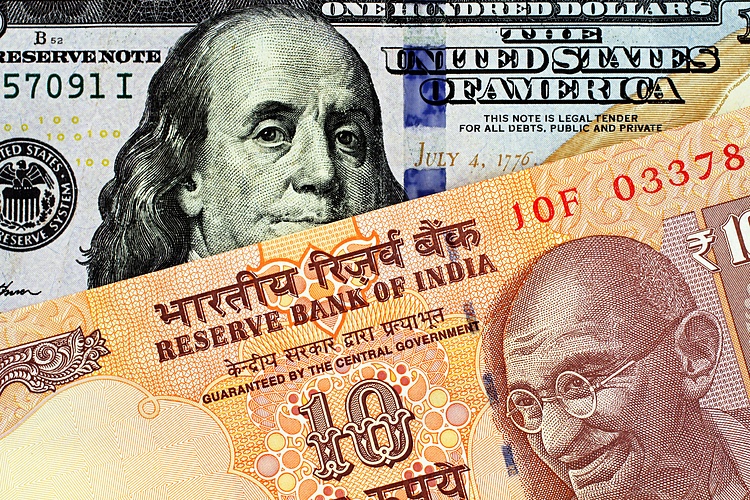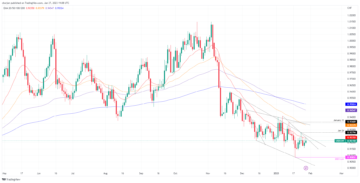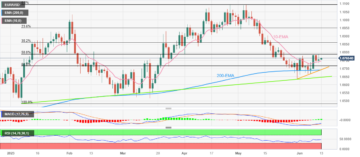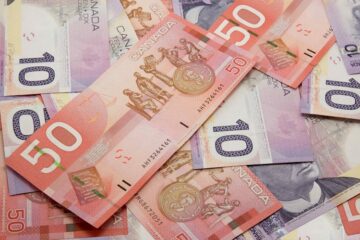
- Indian Rupee trades in negative territory on stronger USD demand.
- The Reserve Bank of India (RBI) MPC decided to keep the key rates unchanged at 6.5% at its April meeting.
- The escalating Middle East geopolitical tensions and the rise in oil prices weigh on the INR.
- Investors will closely watch the US Nonfarm Payrolls (NFP), Unemployment Rate, and Average Hourly Earnings for March, due on Friday.
Indian Rupee (INR) loses its recovery momentum on Friday amid persistent US Dollar (USD) demand, which is most likely from importers. The Reserve Bank of India (RBI) governor Shaktikanta Das said the central bank’s Monetary Policy Committee (MPC) decided decided by a 5 to 1 majority to maintain the repo rate steady at the current level of 6.5%. The Greenback remains firm following the RBI rate decision.
Meanwhile, the rising geopolitical tensions in the Middle East and the upsurge in oil prices exert some selling pressure on the INR and lift the safe-haven currency like the Greenback. However, the downside of the local currency might be limited by the RBI’s two-way FX intervention to keep the INR stable.
Moving on, the US employment data will be due later on Friday, including Nonfarm Payrolls (NFP), Unemployment Rate, and Average Hourly Earnings for March. The US NFP figure is estimated to see 200K jobs added to the US economy in March.
Daily Digest Market Movers: Indian Rupee remains weak amid geopolitical tension
- RBI governor Shaktikanta Das said robust growth prospects allow the MPC enough room to focus on inflation and allow it to move towards the target of 4%. Monetary policy must continue to be actively disinflationary.
- RBI governor Shaktikanta Das said robust growth prospects allow the MPC enough room to focus on inflation and allow it to move towards the target of 4%. Monetary policy must continue to be actively disinflationary.
- RBI retained inflation forecast at 4.5% for the current financial year, lower than 5.4% in the last fiscal.
- RBI’s Das highlighted the need to be cautious about food prices, considering the expectation of rising temperatures between April and June. He added that the impact of a reduction in fuel prices on inflation will deepen in the coming months.
- The CIA on Thursday reportedly warned Israel that Iran will attack within the next 48 hours after Israel attacked Tehran’s consulate in Syria, killing two Iranian military leaders, per the Express.
- India’s HSBC Service PMI rose to 61.2 in March from 60.6 in February, better than market expectations.
- The INR will strengthen only marginally against the USD over the coming three months as the RBI uses its FX reserves to manage volatility and keep the currency relatively strong, according to a Reuters poll.
- The INR exchange rate would be unaffected by the recent volatility in the currency’s exchange-traded derivatives, which was caused by traders unwinding positions to comply with a central bank rule, four bankers said on Thursday.
- The US Initial Jobless Claims for the week ended March 30 rose by 9,000 to 221,000 from the previous week of 212,000, below the market consensus of 214,000. The Continuing Claims declined by 19K to 1.791M in the week ended March 23.
- Fed Bank of Richmond President Thomas Barkin said disinflation is likely to continue, but the speed of that remains unclear. He further stated that maintaining rates ‘somewhat restrictive’ will bring inflation back to target.
Technical analysis: USD/INR prospects remain positive in the longer term
The Indian Rupee trades weaker on the day. The bullish stance of USD/INR remains unchanged in the long term since the pair has risen above a nearly four-month-old descending trend channel since March 22.
In the short term, USD/INR is above the key 100-day Exponential Moving Average (EMA) on the daily chart, with the 14-day Relative Strength Index (RSI) holding in bullish territory around 65.0. This suggests that support zones are more likely to hold than to break.
A break past a high of April 3 at 83.55 could pave the way to the next resistance level at an all-time high of 83.70 en route to the 84.00 psychological round mark. On the flip side, the first downside target will emerge near a high of March 21 at 83.20. The potential support level is located at the 83.00–83.50 zone (round mark, the 100-day EMA). A breach of this level could see a drop to a low of March 14 at 82.80.
US Dollar price in the last 7 days
The table below shows the percentage change of US Dollar (USD) against listed major currencies in the last 7 days. US Dollar was the strongest against the Canadian Dollar.
| USD | EUR | GBP | CAD | AUD | JPY | NZD | CHF | |
| USD | -0.32% | 0.00% | 0.24% | -0.83% | -0.12% | -0.61% | 0.13% | |
| EUR | 0.34% | 0.31% | 0.58% | -0.49% | 0.22% | -0.29% | 0.46% | |
| GBP | 0.01% | -0.31% | 0.27% | -0.81% | -0.09% | -0.61% | 0.14% | |
| CAD | -0.25% | -0.57% | -0.26% | -1.07% | -0.39% | -0.88% | -0.13% | |
| AUD | 0.83% | 0.48% | 0.79% | 1.06% | 0.71% | 0.21% | 0.94% | |
| JPY | 0.12% | -0.21% | 0.11% | 0.36% | -0.66% | -0.48% | 0.25% | |
| NZD | 0.62% | 0.29% | 0.60% | 0.87% | -0.22% | 0.51% | 0.75% | |
| CHF | -0.13% | -0.47% | -0.07% | 0.19% | -0.94% | -0.27% | -0.77% |
The heat map shows percentage changes of major currencies against each other. The base currency is picked from the left column, while the quote currency is picked from the top row. For example, if you pick the Euro from the left column and move along the horizontal line to the Japanese Yen, the percentage change displayed in the box will represent EUR (base)/JPY (quote).
RBI FAQs
The role of the Reserve Bank of India (RBI), in its own words, is ‘..to maintain price stability while keeping in mind the objective of growth.” This involves maintaining the inflation rate at a stable 4% level primarily using the tool of interest rates. The RBI also maintains the exchange rate at a level that will not cause excess volatility and problems for exporters and importers, since India’s economy is heavily reliant on foreign trade, especially Oil.
The RBI formally meets at six bi-monthly meetings a year to discuss its monetary policy and, if necessary, adjust interest rates. When inflation is too high (above its 4% target), the RBI will normally raise interest rates to deter borrowing and spending, which can support the Rupee (INR). If inflation falls too far below target, the RBI might cut rates to encourage more lending, which can be negative for INR.
Due to the importance of trade to the economy, the Reserve Bank of India (RBI) actively intervenes in FX markets to maintain the exchange rate within a limited range. It does this to ensure Indian importers and exporters are not exposed to unnecessary currency risk during periods of FX volatility. The RBI buys and sells Rupees in the spot market at key levels, and uses derivatives to hedge its positions.
- SEO Powered Content & PR Distribution. Get Amplified Today.
- PlatoData.Network Vertical Generative Ai. Empower Yourself. Access Here.
- PlatoAiStream. Web3 Intelligence. Knowledge Amplified. Access Here.
- PlatoESG. Carbon, CleanTech, Energy, Environment, Solar, Waste Management. Access Here.
- PlatoHealth. Biotech and Clinical Trials Intelligence. Access Here.
- Source: https://www.fxstreet.com/news/usd-inr-attracts-some-buyers-eyes-on-rbi-rate-decision-us-nfp-data-202404050306
- :has
- :is
- :not
- 00
- 000
- 1
- 11
- 14
- 2%
- 20
- 21
- 212
- 214
- 22
- 221
- 23
- 30
- 4
- 41
- 48
- 5
- 50
- 55
- 6
- 60
- 65
- 7
- 70
- 80
- 84
- 9
- a
- About
- above
- According
- actively
- added
- adjust
- After
- against
- allow
- along
- also
- Amid
- an
- analysis
- and
- April
- ARE
- around
- AS
- At
- attack
- attacked
- average
- back
- Bank
- Bank of India
- bankers
- base
- BE
- below
- Better
- between
- Borrowing
- Box
- breach
- Break
- bring
- Bullish
- but
- Buys
- by
- CAN
- Canadian
- Canadian Dollar
- Cause
- caused
- cautious
- central
- Central Bank
- change
- Changes
- Channel
- checked
- cia
- claims
- closely
- Column
- coming
- committee
- comply
- Consensus
- considering
- continue
- continuing
- could
- currencies
- Currency
- Current
- Cut
- daily
- data
- day
- Days
- decided
- decision
- Deepen
- Demand
- Derivatives
- Digest
- discuss
- displayed
- does
- Dollar
- downside
- Drop
- due
- during
- each
- Earnings
- East
- economy
- EMA
- emerge
- employment
- encourage
- ended
- ends
- enough
- ensure
- escalating
- especially
- estimated
- Ether (ETH)
- EUR
- Euro
- example
- excess
- exchange
- Exchange rate
- exchange-traded
- expectation
- expectations
- exponential
- exponential moving average
- exporters
- exposed
- express
- Falls
- FAQ
- far
- February
- Figure
- financial
- Firm
- First
- Fiscal
- Flip
- Focus
- following
- food
- For
- Forecast
- foreign
- foreign trade
- forex
- Formally
- four
- Friday
- from
- Fuel
- further
- FX
- FX markets
- geopolitical
- Governor
- Greenback
- Ground
- Growth
- he
- heavily
- hedge
- High
- Highlighted
- hold
- holding
- holds
- Horizontal
- HOURS
- However
- HSBC
- HTTPS
- if
- Impact
- importance
- in
- Including
- index
- india
- Indian
- inflation
- inflation rate
- initial
- interest
- Interest Rates
- intervention
- involves
- Iran
- Iranian
- Israel
- IT
- ITS
- Japanese
- Japanese Yen
- jobless claims
- Jobs
- jpg
- june
- Keep
- keeping
- Key
- key levels
- killing
- Last
- later
- leaders
- left
- lending
- Level
- levels
- like
- likely
- Limited
- Line
- Listed
- local
- located
- Long
- longer
- Loses
- Low
- lower
- maintain
- maintaining
- maintains
- major
- Majority
- manage
- map
- March
- marginally
- mark
- Market
- Markets
- meeting
- meetings
- Meets
- Middle
- Middle East
- might
- Military
- mind
- module
- Momentum
- Monetary
- Monetary Policy
- monetary policy committee
- months
- more
- most
- move
- Movers
- moving
- moving average
- MPC
- must
- Near
- nearly
- necessary
- Need
- negative
- negative territory
- next
- nfp
- Nonfarm
- Nonfarm Payrolls
- normally
- objective
- of
- Oil
- on
- only
- Other
- over
- own
- pair
- past
- pave
- Payrolls
- per
- percentage
- periods
- pick
- picked
- plato
- Plato Data Intelligence
- PlatoData
- pmi
- policy
- poll
- positions
- positive
- potential
- president
- pressure
- previous
- price
- Prices
- primarily
- problems
- prospects
- psychological
- quote
- raise
- range
- Rate
- Rates
- RBI
- RBI rate decision
- recent
- recovery
- reduction
- relative
- relative strength index
- Relative Strength Index (RSI)
- relatively
- remain
- remains
- reportedly
- represent
- Reserve
- reserve bank
- Reserve Bank of India
- reserves
- Resistance
- Restrictive
- Reuters
- Rise
- Risen
- rising
- Risk
- robust
- Role
- Room
- ROSE
- round
- Route
- ROW
- rsi
- Rule
- s
- Said
- see
- Selling
- Sells
- service
- Short
- Shows
- side
- since
- SIX
- some
- somewhat
- speed
- Spending
- Spot
- spot market
- Stability
- stable
- stance
- starts
- stated
- Status
- steady
- strength
- Strengthen
- strong
- stronger
- strongest
- Suggests
- support
- support level
- Syria
- table
- Target
- tehran
- tensions
- term
- territory
- than
- that
- The
- The Reserve Bank of India
- this
- thomas
- three
- thursday
- to
- too
- tool
- top
- towards
- trade
- Traders
- trades
- Trend
- two
- unaffected
- unchanged
- unclear
- unemployment
- unemployment rate
- unnecessary
- us
- US Dollar
- US economy
- US Initial Jobless Claims
- us NFP
- US nonfarm payrolls
- US nonfarm payrolls (NFP)
- USD
- usd/inr
- uses
- using
- v1
- Volatility
- warned
- was
- Watch
- Way..
- weaker
- week
- weigh
- when
- which
- while
- will
- with
- within
- words
- would
- year
- Yen
- you
- zephyrnet
- zone
- zones












